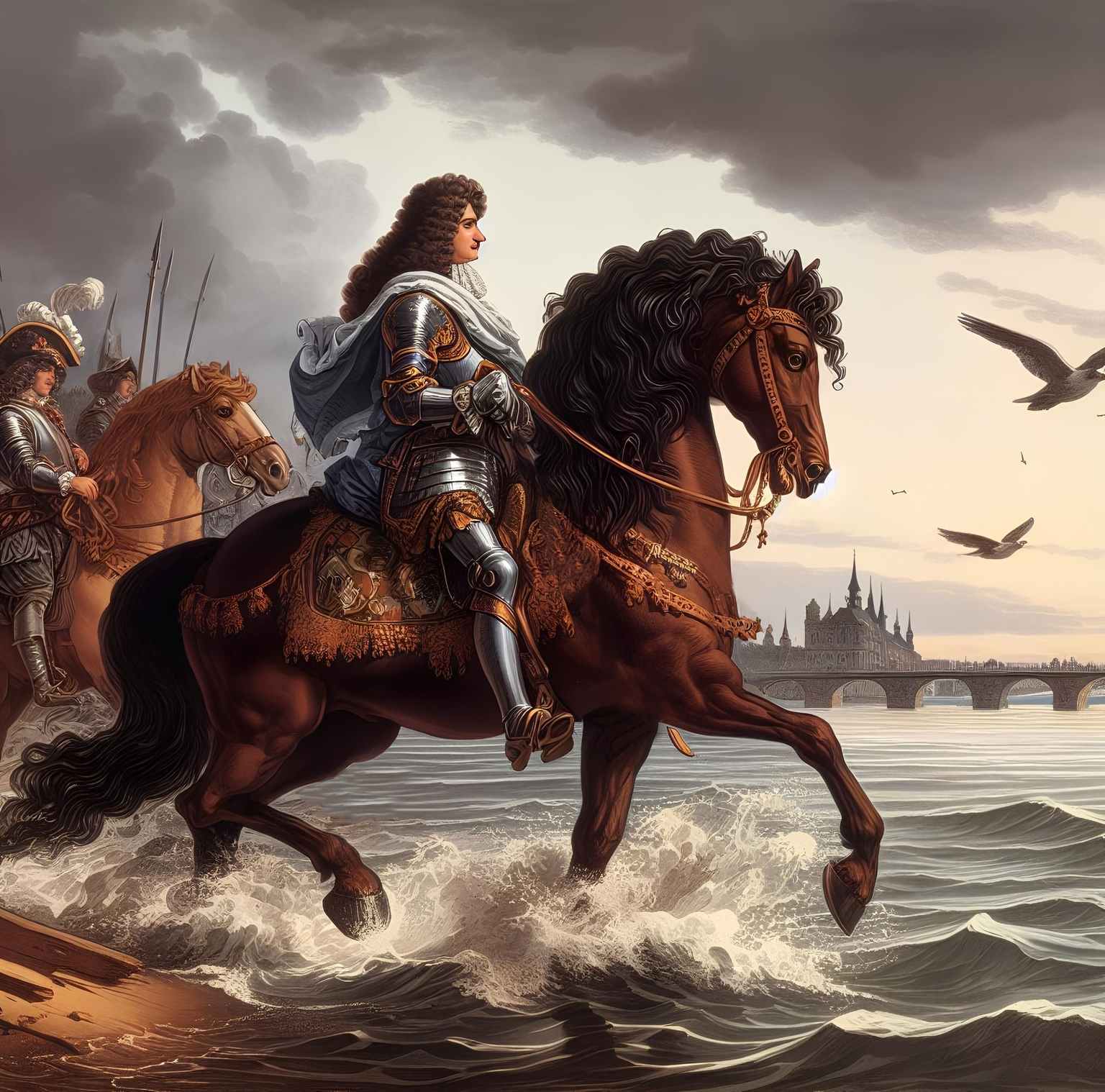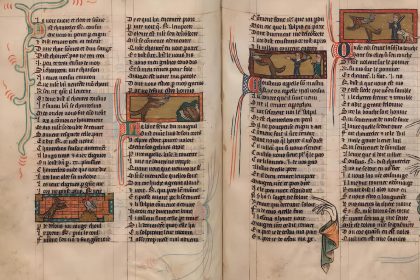Louis XIV pushed France into the Dutch War with the intention of weakening the United Provinces of the Netherlands. After a concerted diplomatic effort to convert Sweden and England to the French cause a few years earlier, he began the attack in 1672. On March 28, 1672, England, an ally of France, was the first country to engage in the war. On April 6, France launched a counterattack against the United Provinces.
The Dutch Stadtholder, William III of Orange, put up a strong fight against the French despite their effective progress in the early months.
He managed to rally his troops and form an alliance against France, which included the Holy Roman Empire, Spain, Brandenburg, and Denmark. Attacked on three fronts, France ultimately forced the coalition to sign the Treaty of Nijmegen in 1678. France relinquished the United Provinces but secured its northern and eastern borders.
Causes of the Dutch War
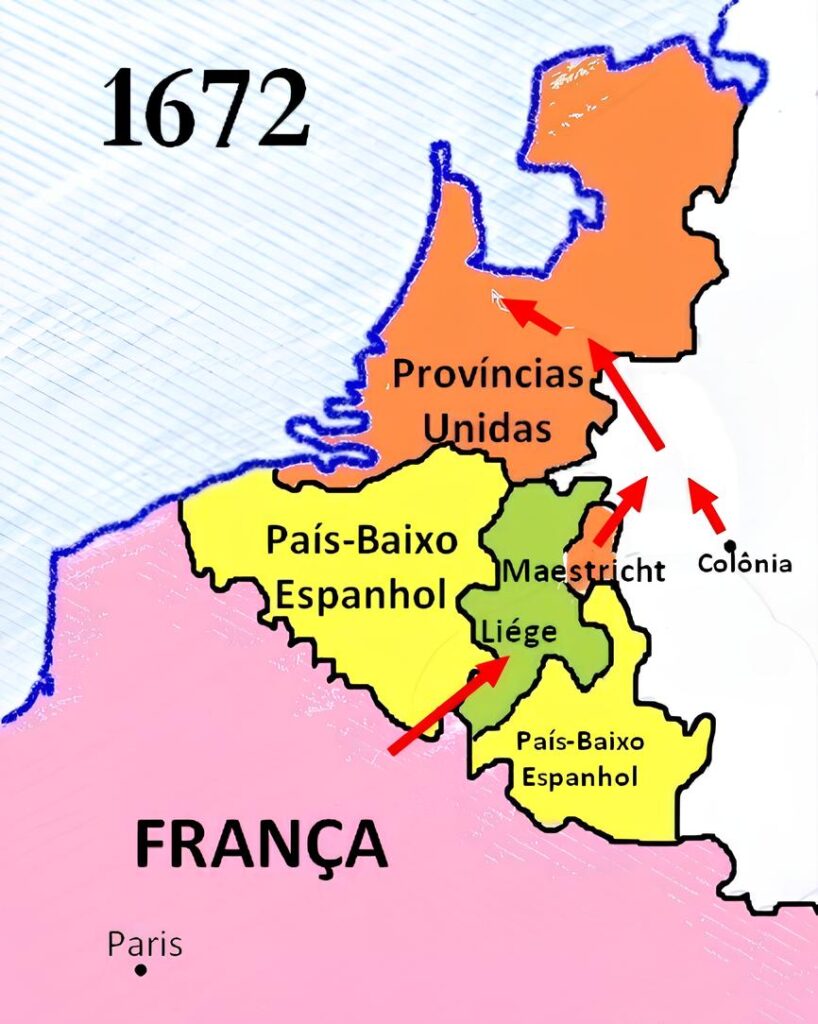
Louis XIV initiated the Dutch War with the aim of weakening the United Provinces and countering the Triple Alliance (England, Sweden, and the United Provinces). The United Provinces, referring to the seven northern provinces of the Netherlands, had established themselves as a major naval and commercial power in Europe for several decades. Louis XIV was concerned that the United Provinces would thwart his expansionist goals by preventing him from acquiring the Spanish territories that made up the Spanish Netherlands.
Before the conflict began, France unsuccessfully attempted to impose highly protectionist customs duties to reduce the commercial competition from the United Provinces. Seeing that this strategy had no effect, France chose to pursue an aggressive diplomatic campaign by forming alliances with England and Sweden.
By doing so, Louis XIV isolated the United Provinces from their Triple Alliance allies. Ultimately, it was England that declared war on the United Provinces on March 28, 1672, followed by France on April 6, 1672.
The war began due to Louis XIV’s territorial ambitions and his desire to annex portions of the Spanish Netherlands. He claimed that he had the right to these territories through his marriage to the Spanish Infanta Maria Theresa.
Course of the Dutch War
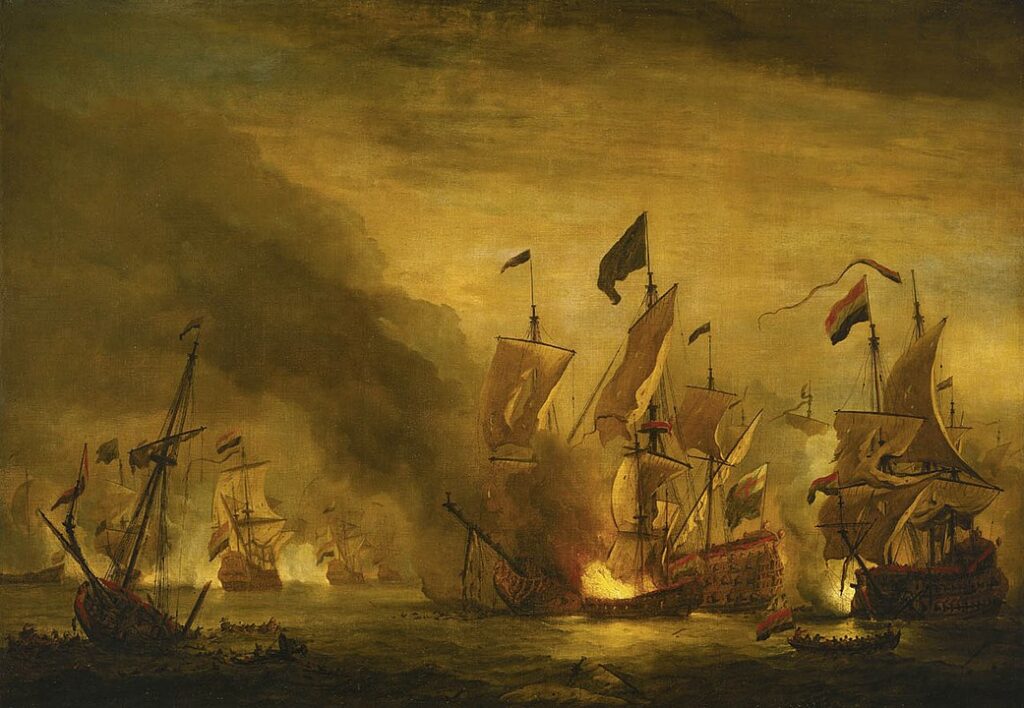
The Dutch War involved multiple fronts, including the North Sea, the Spanish Netherlands, Franche-Comté (a Spanish territory at the time), and Alsace. Some battles even took place in the Mediterranean, pitting the French admiral Duquesne against his Dutch counterpart, Ruyter. Less than three months after the war’s outbreak, the United Provinces, though outnumbered, dealt a blow to the Franco-English fleet at the Battle of Solebay on June 7, 1672, off the east coast of England. This naval battle resulted in significant losses on both sides, but the Franco-English blockade plans against Dutch ports failed.
While the maritime invasion proved disastrous for the French, the land invasion promised a more favorable outcome. Conquests were made at Orsoy, Wesel, and Rheinberg. On June 12, 1672, the Rhine was crossed, and other towns were besieged, thanks in part to the efforts of the Duke of Luxembourg. The Prince-Bishop of Münster, an ally of Louis XIV, began the siege of Groningen on July 9, 1672. However, Dutch forces eventually halted the offensive after a month and a half of fighting. In June 1673, the French captured Maastricht, a particularly significant gain.
A year later, Turenne, tasked with containing the Imperial forces, crossed the Rhine and achieved victories at Sinsheim and Ladenburg in June and July 1674, respectively. On the northern front, it was Condé who thwarted William of Orange’s troops on August 11, 1674, at the Battle of Seneffe. Fought on three fronts, namely Franche-Comté, the Spanish Netherlands, and Alsace, the war left its mark, compelling the coalition to seek peace.
Commencing on March 28, 1672, the Dutch War concluded with the Treaty of Nijmegen on August 10, 1678, signed with the United Provinces. Nevertheless, the conflict continued with the other belligerents, each signing separate treaties with France (the Treaty of Nijmegen for the Holy Roman Empire, the Treaty of Fontainebleau for Denmark, and the Treaty of Saint-Germain-en-Laye for Brandenburg).
Naval warfare played a crucial role in the Franco-Dutch War. King Charles II oversaw the British Royal Navy, which played a complicated role. Although nominally part of the Triple Alliance, Britain protected its own interests and sometimes cooperated with France. Notable naval conflicts included the Battle of Solebay in 1672, where English and French fleets clashed with the Dutch.
These naval conflicts had a lasting impact on the balance of power in Europe.
Participants in the Dutch War
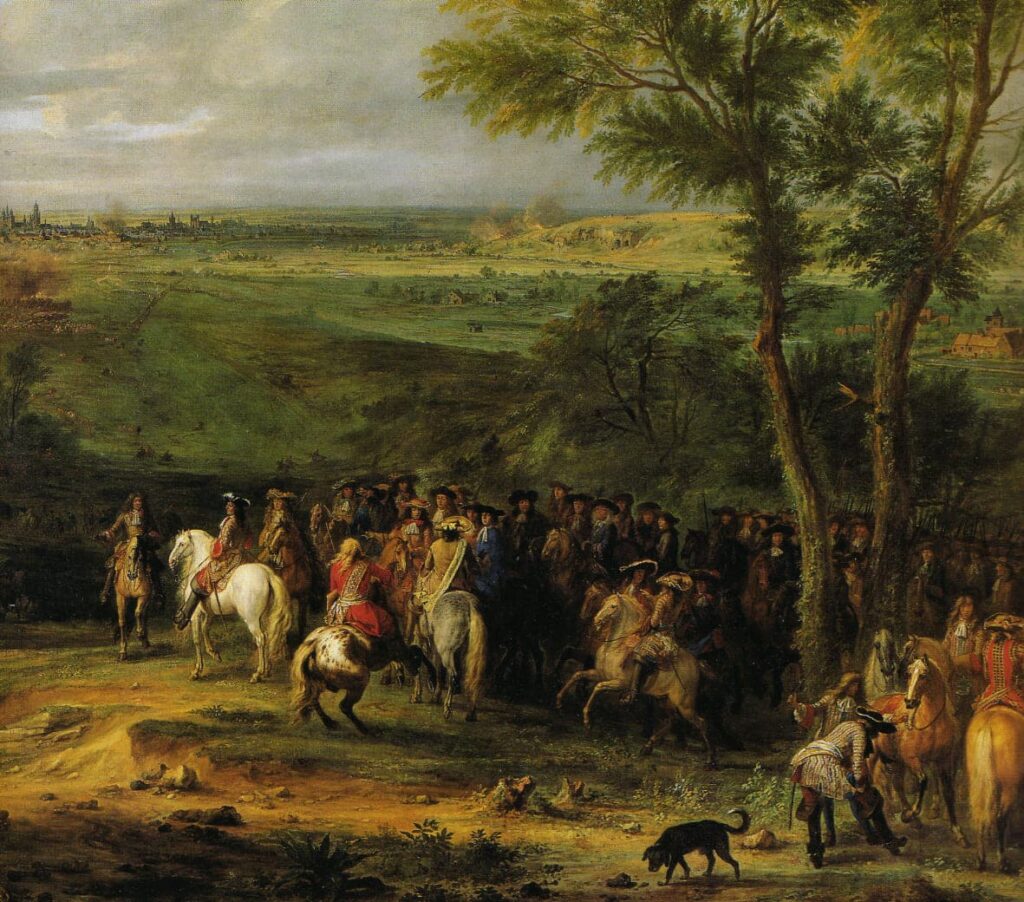
From the perspective of states, the Dutch War pitted the Quadruple Alliance against France’s allies. The Quadruple Alliance united the United Provinces, the Archduchy of Austria, the Spanish Catholic Monarchy, and the Duchy of Lorraine. Their common enemy was the Kingdom of France under Louis XIV. To weaken the powerful United Provinces, France allied itself with England, Sweden, Bavaria, Liège, and the Principality of Münster.
Leading figures in Europe were also involved in this war. King Louis XIV could count on the support of Charles II of England and Charles XI of Sweden. On the opposing side, the main leaders of the Quadruple Alliance included William III of Orange, the Stadtholder of the United Provinces, as well as Holy Roman Emperor Leopold I, Frederick William I of Brandenburg, Elector of Brandenburg and Duke of Prussia, and King Christian V of Denmark and Norway.
William III of Orange, also known as William of Orange, was a prominent Dutch leader who played a crucial role in leading the Dutch Republic’s defense against French forces during the war. He later became King William III of England.
Outcome of the Dutch War

After years of war and despite several remarkable achievements, the Dutch suffered significantly from the conflict, with colossal human and commercial losses. However, in 1677, the marriage of Mary of York, niece of Charles II of England, to William of Orange marked a turning point by cementing an alliance between England and the United Provinces. Fearing the effects of this alliance, Louis XIV intensified his efforts and, at the beginning of 1678, ordered the capture of Ghent, Ypres, and Puycerda.
During the negotiations in Nijmegen, the negotiators agreed on the main conditions of peace. Louis XIV insisted that Sweden, his devoted ally, reclaim the Swedish territories that Denmark and Brandenburg had taken during the war.
However, the major winner was France, which saw its northern and eastern borders strengthened at the expense of Spain, which had to cede Franche-Comté. Even before that, England and the United Provinces had settled their differences in the Treaty of Westminster in 1674, resulting in a status quo ante bellum.
Important Battles and Campaigns
Battle of Solebay (1672)
The Battle of Solebay was an important naval engagement that took place on May 28, 1672, during the Franco-Dutch War. It took place off the coast of Suffolk, England, near Solebay (now Sole Bay). The Duke of York (later King James II of England) and Admiral Comte de Tourville, leading the English and French fleets, respectively, engaged the fleet of the Dutch Republic under Admiral Michiel de Ruyter.
Traditionally wary of the Dutch Republic’s dominance in trade and sea power, the English joined forces with the French to challenge Dutch naval supremacy. Ultimately, it ended inconclusively, with both sides claiming victory. However, the Dutch fleet managed to hold its position, preventing the British and French from achieving their objectives, which included the planned invasion of the Dutch Republic.
Siege of Utrecht (1673)
The Siege of Utrecht was a land battle that took place between June 13 and July 30, 1673, during the Franco-Dutch War. The city of Utrecht, in the heart of the Dutch Republic, was a strategic target for French and English forces. The siege marked a critical stage in the conflict, demonstrating the resilience of the Dutch defenses.
With assistance from British forces, Louis II de Bourbon, Prince of Condé, led the French army as it besieged Utrecht. The Dutch, led by William III of Orange, mounted a determined defense using innovative fortifications and a network of water defenses. The protracted siege and the tenacity of the Dutch led to a stalemate and eventually the siege was lifted. The failure to capture Utrecht was a significant setback for the Franco-British alliance.
Naval Battles in the Mediterranean
In addition to major conflicts in the North Sea and the English Channel, the Franco-Dutch War also saw several naval battles in the Mediterranean. These conflicts occurred as part of the wider struggle between France and the Dutch Republic and had far-reaching consequences for trade and colonial interests. The Mediterranean theater was the scene of battles between the French and Dutch fleets, and at times other Mediterranean powers joined in.
Treaty of Westminster (1674)
The Treaty of Westminster was signed on February 19, 1674, and determined the outcome of the Franco-Dutch War. The treaty was negotiated between England and the Dutch Republic. The treaty effectively ended England’s participation in the war after it withdrew from its alliance with France.
The terms of the treaty included provisions on mutual defense, trade agreements, and territorial arrangements. Key agreements included the return of British colonial conquests, such as New Netherland to Dutch control. This treaty significantly changed the balance of power in Europe and paved the way for a more favorable period in Dutch-British relations.
The Treaty of Westminster had lasting effects not only in the context of the Franco-Dutch War but also in the context of European politics and colonial possessions in the late 17th century. It reshaped alliances and rivalries in the region and contributed to the relative decline of French influence.
Consequences of the Dutch War
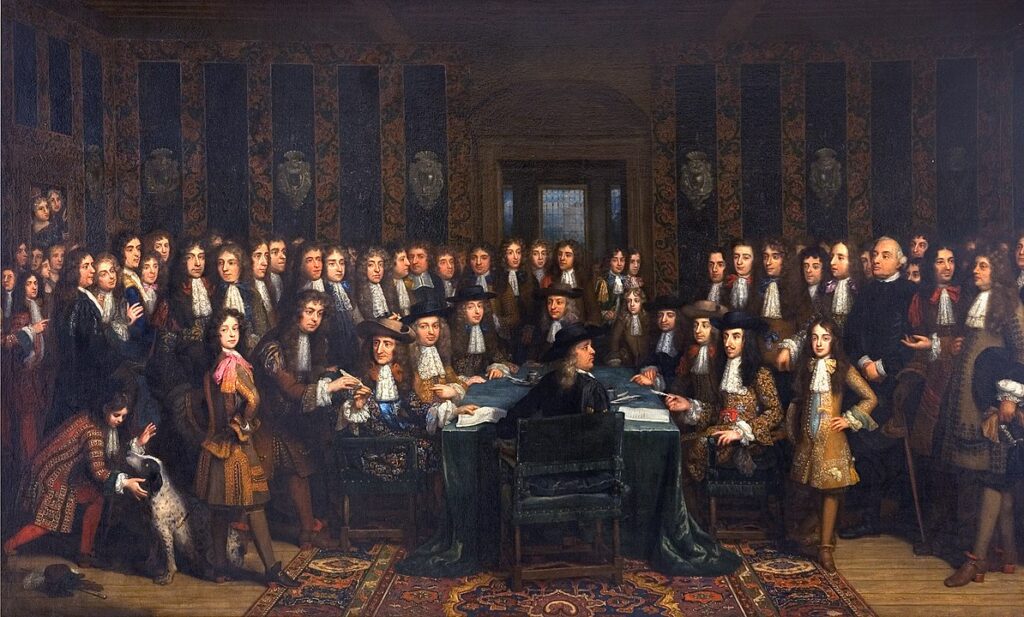
The Dutch War and the Treaty of Nijmegen somewhat altered the landscape of Europe. France emerged as the major winner, with smoother northern borders. With fewer enclaves due to gains in various strongholds such as Ypres, Saint-Omer, Cambrai, and Valenciennes, France became easier to defend and administer. However, this came at the expense of returning several enclaves, like Maastricht and the Principality of Orange, to William III, as well as Charleroi and Courtrai to Spain.
Louis XIV also acquired Franche-Comté from Spain. Regarding Lorraine, it was returned to its duke by Emperor Leopold I of Habsburg under the Treaty of February 5, 1679. However, as the duke refused to comply with the treaty, Lorraine remained occupied by France.
The Treaty of Nijmegen was a humiliation for Spain. It was the major loser in the territorial division. Despite some concessions in the Spanish Netherlands by France, such as Charleroi, Binche, and Courtrai, Spain had to part with Franche-Comté and several strongholds like Cambrai, Saint-Omer, Ypres, or Valenciennes. The military defeat also had diplomatic repercussions for Spain.
Following the Glorious Revolution of 1688 in England, William of Orange, husband of Mary Stuart, daughter of James II, ascended to the English throne alongside Mary. The Glorious Revolution was partly motivated by the fears of the English elite regarding the possible restoration of Catholicism in England under James II’s reign. William of Orange, as a Protestant and Stadtholder of the United Provinces, was seen as a leader capable of ensuring the preservation of Protestant liberties in England.


